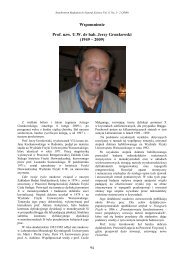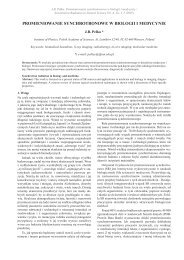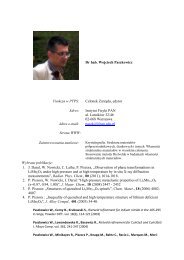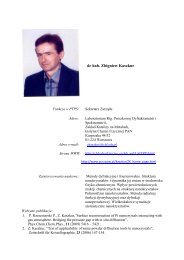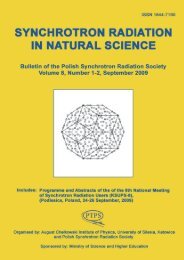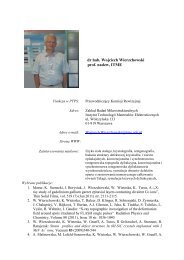CHALLENGES IN X-RAY OPTICS FOR MODERN X-RAY SOURCES
CHALLENGES IN X-RAY OPTICS FOR MODERN X-RAY SOURCES
CHALLENGES IN X-RAY OPTICS FOR MODERN X-RAY SOURCES
You also want an ePaper? Increase the reach of your titles
YUMPU automatically turns print PDFs into web optimized ePapers that Google loves.
ISSRNS 2010: Extended abstracts / Synchrotron Radiation in Natural Science Vol. 9, No. 1 – 2 (2010)bFigure 2. Comparison of an X-ray topograph of an old,long time ago installed beam splitter out of nitrogenrich type Ib material (a) with an example of a newhigh quality plate (b).The lateral (horizontal) dimension of the crystal in (a)is about 5 mm and that in (b) about 11 mm.Synthetic single-crystalline HPHT-diamond is inprinciple the best-suited material for Bragg diffracting X-ray optical elements like beamsplitters ormonochromators to be used in modern, powerful X-raysources. Already in the early days of the 3 rd generationsources the utilisation of diamonds was discussed, testedand X-ray optical elements were realised. However, aareal break through in their application was not reached.The main reasons were, (and partly still are) bycomparison with silicon, the low quality (bulk andsurface), the limited availability and the smalldimensions of the available material.Since then a substantial effort was undertaken (andneeds to be continued) in the fields of crystal growth,crystal processing and crystal characterisation to developa high-quality diamond material is needed that combinesthe extremely high perfection of the crystal bulk with anexcellent surface finish [1]. With regard to the quality ofthe crystal bulk, selected samples became available thatlocally may be dislocation free, with a very low level oflocal residual strain. However, at the moment the surfacequality appears to be the most critical point to bothachieve and study.High quality type IIa (very low nitrogen impurityconcentration) HPHT Diamond plates were investigatedwith white beam X-ray topography and in particular withhigh strain sensitive non-dispersive double crystaltopography [2]. The results showed and confirmed theexcellent local quality of present (selected) plates. Thismeans that they contained large (for diamond)dislocation free regions and an extremely low residualstrain level in the range below several 10 -8 . This is a localstrain level like in FZ silicon.References[1] R.C. Burns, A.I. Chumakov, S.H. Connell, D. Dube, H.P.Godfried, J.O. Hansen, J. Härtwig, J. Hoszowska, F.Masiello, L. Mkhonza, M. Rebak, A. Rommevaux, R.Setshedi, P. Van Vaerenbergh, "HPHT – growth and X-raycharacterisation of high-quality type IIa diamond”, J. Phys.:Condens. Matt. 21 (2009) 364224–1–14.[2] R.C. Burns, A. Chumakov, G. Carbone, S.H. Connell, D.Dube, H.P. Godfried, J.O. Hansen, J. Härtwig, F. Masiello,M. Rebak, A. Rommeveaux, R. Setshedi, P. VanVaerenbergh, A. Gibaud, "Diamonds for X-ray opticalapplications at 3 rd and 4 th generation X-ray sources", Proc.of SPIE Vol. 6705 (2007) 67050K1–6.159



